Items filtered by date: September 2025
What You Need to Know About a Tailors Bunion
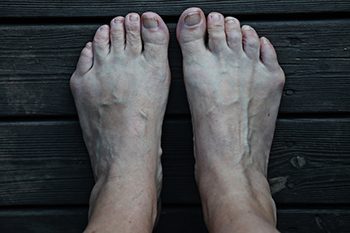
A tailor’s bunion, also known as a bunionette, is a painful bump that forms on the outside of the foot at the base of the little toe. It may appear red, swollen, or callused and often becomes irritated by tight or narrow shoes. The condition can feel sore or sharp when walking or wearing certain shoes. Causes include inherited foot structure, pressure from ill-fitting shoes, or abnormal foot mechanics. Symptoms may worsen over time if left untreated. A podiatrist can diagnose a tailor's bunion through a physical exam and imaging, such as X-rays, to assess the alignment of the toe and surrounding joints. Conservative treatment options include shoe modifications, padding, and orthotics to reduce pressure. Anti-inflammatory medications may be prescribed for pain relief. In more severe cases, surgery may be recommended to realign the toe and remove the bony prominence. It is suggested that you make an appointment with a podiatrist for proper diagnosis and personalized treatment.
If you are suffering from bunion pain, contact one of our podiatrists of Lakewood Family Foot and Ankle. Our doctors can provide the care you need to keep you pain-free and on your feet.
What Is a Bunion?
Bunions are painful bony bumps that usually develop on the inside of the foot at the joint of the big toe. As the deformity increases over time, it may become painful to walk and wear shoes. Women are more likely to exacerbate existing bunions since they often wear tight, narrow shoes that shift their toes together. Bunion pain can be relieved by wearing wider shoes with enough room for the toes.
Causes
- Genetics – some people inherit feet that are more prone to bunion development
- Inflammatory Conditions - rheumatoid arthritis and polio may cause bunion development
Symptoms
- Redness and inflammation
- Pain and tenderness
- Callus or corns on the bump
- Restricted motion in the big toe
In order to diagnose your bunion, your podiatrist may ask about your medical history, symptoms, and general health. Your doctor might also order an x-ray to take a closer look at your feet. Nonsurgical treatment options include orthotics, padding, icing, changes in footwear, and medication. If nonsurgical treatments don’t alleviate your bunion pain, surgery may be necessary.
If you have any questions, please feel free to contact our office located in Lakewood, CA . We offer the newest diagnostic and treatment technologies for all your foot care needs.
Understanding Pain on the Outer Side of the Foot
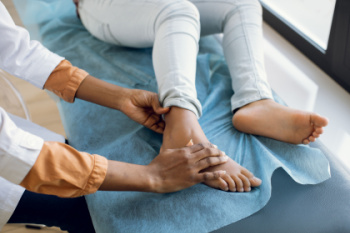
Pain on the outer side of the foot, also known as lateral foot pain, can be caused by a variety of conditions including stress fractures, tendonitis, ankle sprains, or a condition called cuboid syndrome. This type of pain may feel sharp, aching, or burning and often worsens with walking, running, or standing for long periods. Swelling, bruising, or a visible bump may appear, and the foot may feel weak or unstable. The discomfort can range from mild to severe, sometimes making it difficult to wear shoes or bear weight on the affected foot. A podiatrist can assess the issue through a detailed examination, medical history, and diagnostic imaging, such as an X-ray or MRI. Depending on the diagnosis, treatment may include orthotics, targeted exercises, immobilization, or in some cases, surgery. Early intervention can prevent the condition from worsening. It is suggested that you make an appointment with a podiatrist to identify the cause and begin effective treatment.
Foot Pain
Foot pain can be extremely painful and debilitating. If you have a foot pain, consult with one of our podiatrists from Lakewood Family Foot and Ankle. Our doctors will assess your condition and provide you with quality foot and ankle treatment.
Causes
Foot pain is a very broad condition that could be caused by one or more ailments. The most common include:
- Bunions
- Hammertoes
- Plantar Fasciitis
- Bone Spurs
- Corns
- Tarsal Tunnel Syndrome
- Ingrown Toenails
- Arthritis (such as Gout, Rheumatoid, and Osteoarthritis)
- Flat Feet
- Injury (from stress fractures, broken toe, foot, ankle, Achilles tendon ruptures, and sprains)
- And more
Diagnosis
To figure out the cause of foot pain, podiatrists utilize several different methods. This can range from simple visual inspections and sensation tests to X-rays and MRI scans. Prior medical history, family medical history, and any recent physical traumatic events will all be taken into consideration for a proper diagnosis.
Treatment
Treatment depends upon the cause of the foot pain. Whether it is resting, staying off the foot, or having surgery; podiatrists have a number of treatment options available for foot pain.
If you have any questions, please feel free to contact our office located in Lakewood, CA . We offer the newest diagnostic and treatment technologies for all your foot care needs.
How Should Heels Fit for Healthy Feet
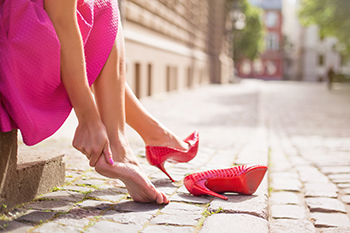
High heels should fit securely and comfortably to support proper foot alignment and prevent pain. When heels are too big, the foot slips forward, causing blisters and instability. If they are too small, they can pinch the toes and create corns or bunions. Shoes that are too narrow may lead to nerve compression or hammertoes, while heels that are too wide fail to provide support, increasing the risk of falls. Poorly fitted high heels can contribute to chronic pain and long-term foot conditions over time. A podiatrist can help by diagnosing problems caused by ill-fitting footwear and offer effective treatment solutions. If you have developed foot pain from wearing high-heeled shoes that do not fit correctly, it is suggested that you consult a podiatrist who can treat various foot conditions.
Getting the right shoe size is an important part of proper foot health. Seek the assistance of one of our podiatrists from Lakewood Family Foot and Ankle. Our doctors will provide the care you need to keep you pain-free and on your feet.
Getting the Right Shoe Size
There are many people who wear shoes that are the incorrect size, negatively affecting their feet and posture. Selecting the right shoes is not a difficult process, so long as you keep several things in mind when it comes to choosing the right pair.
- When visiting the shoe store, use the tools available to measure your foot.
- Be sure there is ‘wiggle room’. There should be about an inch between your toes and the tip of your shoes.
- Do not always assume you are the same size, as manufacturers run differently.
- Purchase shoes later in the day, as your feet swell as the day progresses.
- If a shoe is not comfortable, it is not suitable. Most shoes can’t be ‘broken in’, and comfort should be the ultimate goal when it comes to choosing the right pair of shoes
As our feet hold our body weight and keep us moving, it is important to treat them right. Picking the right pair of shoes can provide your feet comfort and mobility without pain.
If you have any questions, please feel free to contact our office located in Lakewood, CA . We offer the newest diagnostic and treatment technologies for all your foot care needs.
Plantar Warts Can Be Treated!
Understanding Stress Fractures in Athletes
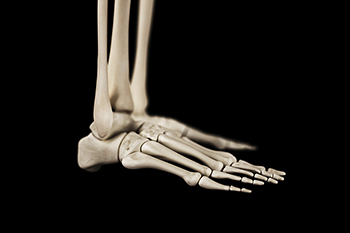
A stress fracture is a small crack in a bone that often develops from repetitive stress rather than a sudden injury. Athletes are particularly prone to stress fractures due to recurring movements, overtraining, wearing poor footwear, or sudden increases in activity. Symptoms include localized pain, swelling, and discomfort that worsens with activity. Managing stress fractures usually involves rest, activity modification, supportive footwear, and a gradual return to sports. A podiatrist can provide an accurate diagnosis through imaging, recommend treatment options, and guide rehabilitation to prevent further injury. If you are experiencing persistent foot pain or suspect a stress fracture, it is suggested that you promptly visit a podiatrist for expert care to help you heal properly and return to your activities safely.
Activities where too much pressure is put on the feet can cause stress fractures. To learn more, contact one of our podiatrists from Lakewood Family Foot and Ankle. Our doctors can provide the care you need to keep your pain free and on your feet.
Dealing with Stress Fractures of the Foot and Ankle
Stress fractures occur in the foot and ankle when muscles in these areas weaken from too much or too little use. The feet and ankles then lose support when walking or running from the impact of the ground. Since there is no protection, the bones receive the full impact of each step. Stress on the feet can cause cracks to form in the bones, thus creating stress fractures.
What Are Stress Fractures?
Stress fractures occur frequently in individuals whose daily activities cause great impact on the feet and ankles. Stress factors are most common among:
- Runners
- People affected with Osteoporosis
- Tennis or basketball players
- Gymnasts
- High impact workouts
Symptoms
Pain from the fractures occur in the area of the fractures and can be constant or intermittent. It will often cause sharp or dull pain with swelling and tenderness. Engaging in any kind of activity which involves high impact will aggravate pain.
If you have any questions please contact our office located in Lakewood, CA . We offer the newest diagnostic and treatment technologies for all your foot and ankle needs.
The Hidden Bursa Behind Your Heel
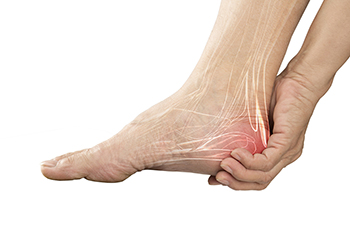
Retrocalcaneal bursitis is a painful condition that affects the small fluid-filled sac located between the heel bone and the Achilles tendon. This bursa helps reduce friction, but when it becomes inflamed, every step can feel uncomfortable. The pain is usually felt at the back of the heel, especially when walking, running, or wearing tight shoes that put pressure on the area. Swelling, tenderness, and stiffness surrounding the heel are also common signs. The condition often develops from overuse, repetitive stress, or footwear that irritates the heel. Athletes and individuals who spend long hours on their feet may be more prone to bursitis. Treatment may involve rest, heel lifts, or changes in footwear to reduce pressure on the tendon and bursa. If pain persists, it is suggested that you see a podiatrist who can provide custom orthotics, targeted exercise, or other advanced treatments to restore comfort.
Many people suffer from bouts of heel pain. For more information, contact one of our podiatrists of Lakewood Family Foot and Ankle. Our doctors can provide the care you need to keep you pain-free and on your feet.
Causes of Heel Pain
Heel pain is often associated with plantar fasciitis. The plantar fascia is a band of tissues that extends along the bottom of the foot. A rip or tear in this ligament can cause inflammation of the tissue.
Achilles tendonitis is another cause of heel pain. Inflammation of the Achilles tendon will cause pain from fractures and muscle tearing. Lack of flexibility is also another symptom.
Heel spurs are another cause of pain. When the tissues of the plantar fascia undergo a great deal of stress, it can lead to ligament separation from the heel bone, causing heel spurs.
Why Might Heel Pain Occur?
- Wearing ill-fitting shoes
- Wearing non-supportive shoes
- Weight change
- Excessive running
Treatments
Heel pain should be treated as soon as possible for immediate results. Keeping your feet in a stress-free environment will help. If you suffer from Achilles tendonitis or plantar fasciitis, applying ice will reduce the swelling. Stretching before an exercise like running will help the muscles. Using all these tips will help make heel pain a condition of the past.
If you have any questions, please feel free to contact our office located in Lakewood, CA . We offer the newest diagnostic and treatment technologies for all your foot care needs.

